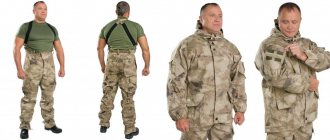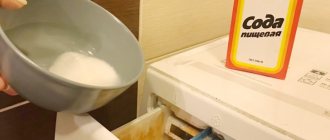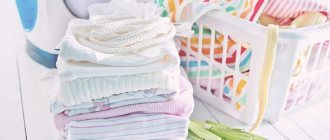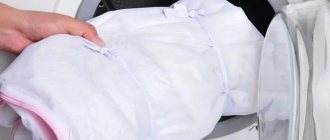What are the main advantages of clothes made of 100% cotton?
- Firstly, cotton products are more durable than their synthetic counterparts.
- Secondly, they are absolutely safe and are recommended for wearing even by children, as they do not cause allergic reactions.
- Cotton clothing is resistant to fairly high temperatures and a large number of washes.
- Moreover, things made from natural fabrics are very pleasant to the touch.
With all its undoubted advantages, cotton has a number of features that require careful treatment and certain care. Otherwise, products made from it quickly become dirty and lose their attractive appearance. Proper washing is one of the criteria for its long life. And if certain rules are not followed, it can quickly become unusable.
Preparing for washing.
Before you start washing, it is important to read the tags on your clothes and make preliminary preparations.
- The first step is to empty your pockets and fasten all zippers and buttons. Clothes should be turned inside out to help maintain their appearance.
- The next step is to carefully arrange things into two piles: white and colored. It is important to keep in mind that if at least one, for example, red sock accidentally ends up in the wrong basket, the items from the other one will take on a pinkish tint after washing.
- To remove stains as much as possible, you need to select the most contaminated items for additional soaking.
How to deal with heavily soiled cotton clothes.
There are several ways to deal with dirty stains on cotton fabric:
- One option is to pre-soak the clothes in warm water with diluted powder in a basin. After a couple of hours, items can be safely mixed with lightly soiled items for further washing.
- The method described above can be done using a washing machine. You need to select the pre-soak mode, load the clothes and add powder to the main and additional wash compartments.
- Washing with a stain remover or oxygen bleach (not for colored items), which is added to a separate compartment of the machine, is effective. They can easily handle blots from chocolate or red wine.
- Wet the stained areas and rub them generously with laundry soap. This will help get rid of stubborn dirt.
Removing stains on 100% cotton using so-called old wives' methods, such as turpentine or vinegar, is highly not recommended. It can destroy things irrevocably. It should also be remembered that it is prohibited to use substances containing chlorine in the washing machine; they can harm both equipment and clothing.
Recommendations for caring for cotton
How to properly wash cotton clothes?
Hand washing in warm water at a temperature of 30 – 40°C is the main advice for the durability of the product. A modern girl does not always have the opportunity to find time for this process, especially if she has a washing machine. The temptation to use modern technologies is very great, there is nothing wrong with that.
The main thing is to take a few seconds to select the correct washing program. Each washing machine has a “Cotton” program and, as a rule, this mode involves selecting high temperatures (60°C, 90°C degrees).
- Important! Choose a delicate wash for cotton material. In the “Cotton” mode, reduce the temperature to 30 – 40°C. Washing at high temperatures is recommended exclusively for bed linen, and then only for white, undyed linen.
- Pay attention to the structure of the material. For example, if it is a tunic made of the finest cotton with lace/embroidery, it is better to resort to hand washing.
- Colored clothes should be washed with powder marked “Color”. Do not use products with bleaching additives, except for crisp white fabrics. If the material has a natural color (milky, light beige), then the fabric is of an unbleached type and the use of bleach powder will leave marks and stains on the material. Colored cotton cannot be bleached at all.
- If you need to wash a stain, do not rub the stained area too hard, soak the item and leave it in water with powder, only then start washing.
- A slight spin will greatly simplify the process of ironing the product, since the creases in the material will not be deep. After spinning, straighten the product by shaking or using your hands. Now you can start drying.
How should you dry cotton clothes?
- Cotton clothes should be dried naturally in an upright position. You can use hangers or clothespins. Do not tumble dry.
- Avoid direct sunlight! This is especially true for dyed fabric, since soon the product will become faded and lose its original attractiveness. Of course, if the item has been in the sun for a little while, nothing bad will happen. The main thing is not to leave it for a long time under the scorching summer sun. Another reason for this is the rapid drying of natural fibers. If an item has been left to air dry for several days, not only will it be more difficult to iron.
- Systematic overdrying of cotton fabric contributes to the destruction of the fabric structure.
How to iron cotton clothes?
- Ironing is performed at high temperature in the “Cotton/Cotton” mode, you can use steam.
- The fabric is ironed damp on the front side, and if there is embroidery or print, on the back side.
- If the item becomes dry during the drying process, it is enough to moisten it with a spray bottle before ironing or use steam (depending on the density of the material).
Features of storing cotton clothes
The process of storing clothes is rarely given serious importance; just putting them in a closet is enough. Yes, everything is so simple, because the closet is the “dry, dark place.”
- Please note that folding cotton items very tightly can lead to deep creases, so you won’t be able to take them out and put them on quickly; you’ll have to iron them. For blouses and dresses, storage on round hangers is suitable. Although cotton is not prone to deformation quickly compared to other fabrics (for example, knitwear, wool), if the item hangs on a sharp hanger for a long time, the corners will still print.
- Did you know that citric acid is harmful to cotton? The structure of the tissue is destroyed in a matter of minutes.
- Another enemy of cotton clothing is natural light, which turns snow-white fabrics yellow.
- The material does not require protection from moths.
Caring for cotton knitwear
In the Simona Polagina online store you can buy a beautiful women's sports suit made of cotton jersey. The manufacturers we cooperate with use high-quality material in their tailoring, but it can easily be damaged if not properly cared for. We are often asked, “Do pilling appear on knitwear?” Yes, they definitely appear due to aggressive friction (for example, a textured bag made of thick leather can damage the product where it touches clothing) or improper care. Therefore, knitwear is often worn under outerwear. This does not apply to walking sports suits; for them, looped cotton knitwear is chosen, which is more wear-resistant and durable.
Here are some features of caring for knitted clothing:
- Knitted items require more careful care than 100% cotton.
- Wash in warm water up to 40°C in soapy water
- We recommend using detergents specifically for knitwear
- Gentle machine wash at low speed
- It is advisable to hand wash and squeeze rather than rub, otherwise it may develop pilling after the first wash.
- Use powder without colored granules or bleach
- Sort knitwear by color
- Knitwear shrinks in hot water
- It is recommended to rinse the knitted fabric first in warm and then in cold water.
- Wring out the products carefully, try not to twist them. To get rid of excess water, wrap the product in a sheet or towel.
- Be sure to dry knitwear horizontally. Cotton knitwear can be dried on a chair/chair back or on special dryers at room temperature. Dried items can be briefly transferred to soft or round items.
- Iron on the reverse side at no more than 110°C.
- Thanks to the looped structure of the knitwear, you can slightly change the fit of the product (straighten, lengthen) when the clothes are still damp.
- Pellets appear due to improper care and friction; they must be removed using a special machine.
- Store soft knitwear folded to prevent the item from pulling under its own weight.
We hope that our tips will help you keep your favorite item and enjoy your purchase for a long time. By the way, you can always ask the manager for recommendations on care, because we have been working in this area for a long time, which means we have already studied all the intricacies!
How not to fit things made of 100% cotton
Unlike wool, planting cotton is not as easy. It is less susceptible to shrinkage when in contact with water, but can still change shape under certain conditions. To prevent this from happening, it is important to follow the recommendations:
- Firstly, you must first familiarize yourself with the tags on things, which indicate the basic criteria for washing. Their violation is fraught with consequences for clothing.
- Secondly, you should not dry 100% cotton items at high temperatures in a machine or on heating radiators. As a result, clothing may be subject to significant deformation.
- To prevent items made from thin cotton fabric from shrinking when washing, you should choose the water temperature as low as possible.
Proper washing of 100% cotton items will keep your favorite items bright color and pleasant softness for a long time.
You can't stop sewing beautifully!
World of fabrics., Recommendations
Hello, friends.
Let's look at what cotton is, the properties, origin and care of cotton fabrics.
Cotton is a fiber of plant origin.
Cotton grows in tropical and subtropical climates. The fiber is almost 100% cellulose.
The cotton fabric is very durable, heat resistant and comfortable to wear. It is particularly hygroscopic , i.e. absorbs a lot of moisture and does not become damp to the touch.
A fabric that under normal conditions contains no more than 9% moisture can absorb up to 40% of its own weight. Thanks to this feature, the paints penetrate deep into the fibers, which gives a special color richness.
Cotton fabrics do not irritate the skin, easily take any shape, do not require special care, and can even be boiled.
Thin cotton fabrics with satin weave are no less elegant than silk.
Mercerized cotton is distinguished by its soft shine, durability and hygroscopicity.
Cotton is an ideal fabric for summer clothes, because it barely warms up, but brushed cotton is much warmer.
If cotton fabrics are not treated with a special compound, they wrinkle heavily and shrink when washed; this must be taken into account when cutting and processing such fabric.
Sometimes cotton fabrics are treated so that products made from them dry quickly after washing and do not require ironing, making them much easier to care for.
If your product combines several types of fabric, including cotton, be sure to wash and iron the piece of cotton fabric before sewing.
Perhaps this will “save” the future product from distortions and shrinkage.
Additionally on the topic:
Preparing fabric for cutting. What does this have to do with the duck?
Share thread and weft thread. Signs of determination
Do I need to decate knitwear?
Non-colored cotton can be washed at up to 95°C, colored cotton at 40°C in a washing machine.
For white cotton, universal washing powder is suitable, for colored cotton - powder for washing thin fabrics or without brightener.
Remember , drying in the dryer rack of your washing machine can cause severe shrinkage!
It is better to iron cotton fabrics before they are completely dry.
I will list some types of cotton and types of cotton fabrics: cambric, gauze, chintz, denim, rosin, satin, teak, calico, percale, nansook, organdy, pique, poplin, voile, etc.
This is interesting:
- In the Middle Ages, people knew that cotton was harvested from a plant, but few people saw the plant. Many believed that animals appeared on this plant, like lambs from which cotton is cut
- The first people to cultivate cotton were ancient tribes living near the Indus River in what is now Pakistan, India and China 6,000 years ago.
- The first recorded cotton harvest in the United States occurred in 1556 in Florida.
- More cotton is used worldwide than any other fabric
- The first machine-woven cotton clothing was made in England in 1730
- The quality of cotton is assessed by three parameters - color, purity and fiber strength.
- During the American Revolution, Britain and France were cut off from cheap American cotton and were forced to purchase expensive cotton from Egypt. After the end of the war everything returned to its place
- Egyptian cotton is considered to be softer and more durable, and therefore more expensive than American cotton.
- Cottonseeds are used to produce oil, flour and husks.
- “Flowing water”, “evening fog”, “woven air” - these were the names of fabrics created in India
- Many Indian fabrics have remained in history under the names of the cities and villages where they were produced, for example, madras, madapolam, etc.
With best wishes, Elena Krasovskaya
This is interesting:
- Fashionable spring coats. Trends...
- Review of sewing materials. Kinds,…
- Types of linings and their features
- How to sew from velvet. Features of choice…
- We sew a transformable skirt. Preparing for...
- How to sew a cape, pareo, skirt or kilt...











